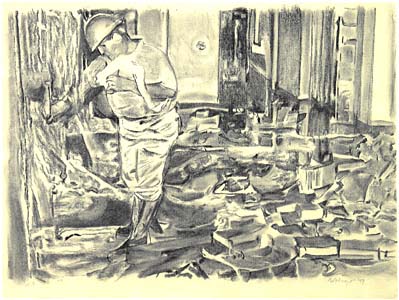 Untitled (Library Fllod), 1997 charcoal on paper, 12 1/2 x 31 1/4 in. Richard Artschwager Drawings 1970 - 2004 Click for English text In rund vierzig Jahren hat der amerikanische Künstler deutscher Abstammung ein vielgestaltiges Werk geschaffen, auf das besonders zwei Prädikate zutreffen - unkonventionell und unberechenbar. Schon anlässlich seiner ersten Einzelausstellung 1965 bei Leo Castelli war die Frage, ob es sich bei seinen Werken primär um Skulpturen oder Gemälde handelt, nur schwer beantworten. "Skulpturen sind für den Tastsinn, Bilder für das Auge. Ich wollte Skulpturen für das Auge und Bilder für den Tastsinn schaffen". Er wurde von ordnungs-liebenden Kritikern verschiedenen Bewegungen zugeord-net: der Pop Art, der Conceptual Art und der Minimal Art. Aber das Werk Artschwagers widersetzt sich erfolgreich jeglicher Kategorisierung. Er ist ein "artist's artist", der seit den 60er-Jahren in jeder Generation seine Bewunderer fand. Berühmt wurde Artschwager mit seinen möbelhaften Objekten, die er aus seinem Lieblingsmaterial, dem Holz und Marmor imitierenden Kunststoff "Formica" herstellte. Er hat nie brauchbare Möbel (Tische, Stühle, Aufzüge. etc.) produziert, sondern spielte gekonnt entlang der Grenze zwischen Künstlichkeit und Nützlichkeit. Seine Gemälde könnte man nach klassischen Kriterien bewerten: Interieurs, Landschaften, Gebäude - sogar Portraits. Was sie aber von konventionellen Gemälden unterscheidet ist die Maltechnik. Nicht die malerische Geste, die Pinsel-führung, schafft die Struktur der meistens in schwarz-weiss gehaltenen Bilder, sondern der Malgrund - die stark strukturierte Oberfläche von Celotex (Hartfaserplatten). Angesichts der Vielfalt seiner konzeptuellen Ambitionen erstaunt es nicht, dass Artschwager parallel zu seinen gegenständlichen Bildern (oft basierend auf Schnapp-schüssen), mit gänzlich abstrakten Bildern das Wesen der Illusion zu erforschen sucht. Der Zeichnung kam immer grosse Bedeutung zu im kreativen Prozess, wovon nicht zuletzt zahlreiche "Notebooks" zeugen, kleinformatige Skizzen mit Einfällen und Einsichten. Die Werke in dieser Ausstellung sind aber alles bildmässig angelegte Blätter und stammen aus autonomen und den Gemälden und Skulpturen eben-bürtigen Werkgruppen. Viele seiner Lieblingsmotive sind vertreten: "Corners", "Weaves", "Upper Right Hand"-Objekte, Landschaften, Gebäude und Katastrophen-szenerien. Aber es ist nicht so sehr das Motiv, das den Betrachter herausfordert, als einmal mehr die Materialität, die Beschaffenheit der Bildoberfläche. Ähnlich den Gemälden tastet das Auge des Betrachters die Fläche der "unscharfen" Zeichnungen ab, bevor ein Bild als Ganzes erfasst werden kann. Wie Seurat, zeichnet Artschwager gerne mit Kohle auf strukturiertes Papier. 1999 schrieb er in eines seiner Notebooks: "Drawing: Paper does some of the work". Die Zeichnungen unserer Ausstellung legen ein lebhaftes Zeugnis seines eigenen Beitrags ab. Richard Artschwager ist in den Sammlungen aller bedeutenden Museen vetreten, darunter das Museum of Modern Art, New York; die Tate Modern, London; das Centre Georges Pompidou, Paris; das Ludwig Museum, Köln; das Kunstmuseum Winterthur. Ausstellungsdauer: 12.6. - 17.7.2004 Oeffnungszeiten: Di-Fr 14 - 18.30 Uhr, Sa 11 - 16 Uhr Galerie Judin Belot Lessingstrasse 5 8002 Zürich Telefon 043 422 88 88 Email judin@galeriejudin.ch www.judinbelot.ch Richard Artschwager Drawings 1970 - 2004 In over forty years, Richard Artschwager, American artist of German descent, has created an oeuvre that could not be more varied in form. His art has always been unconventional and unpredictable. It is often difficult to determine whether a given work was sculpture or painting - this diversity was evident in his first one-man show at Leo Castelli's in 1965. "Sculpture is for the touch, painting is for the eye. I wanted to make a sculpture for the eye and a painting for the touch". He has been called a Pop artist, a conceptual artist and a minimal artist - in an attempt to fit him into recent art history - when in fact, he is a category of his own. Artschwager is an "artist's artist", who has had his admirers in every generation since the 1960s. Artschwager established his international reputation with his furniture-like objects made of "Formica", his hallmark material, with a coloured, marble-effect pattern. He never fabricated "real" objects (tables, chairs, elevators, etc.), playing with the boundary that traditionally separates art from utility. His paintings could be classified in an entirely classical way: interiors, landscapes, and architectural views - even landscapes. The distinctive feature is their technique. Mostly in black-and-white, it is not the painterly gesture that gives them a structure, but the chosen support - the strong texture of Celotex fibreboard. With the conceptual range of his ambition in mind, it is not surprising that Artschwager, simultaneously with his figurative works (often based on found snap-shots), would produce abstract paintings that consciously explore the nature of illusion. Drawing has always been integral to his creative process. While he uses drawing (and photography) to conceive and execute his work, the 30 drawings we present in this exhibition are finished works in their own right. Many of his favourite motifs are represented: Corners, Weaves, "Upper Right Hand"-Objects, Buildings, Landscapes and Scenes of Disasters. It is not the motif but rather the material substance of the picture surface that catches our attention. As with his paintings, the eye first roams freely over the surface and takes in the blurredness. Like Seurat, Artschwager has a preference for textured papers on which he mostly draws with charcoal. As he wrote 1999 into one of his famous notebooks: "Drawing: Paper does some of the work". The drawings in our exhibition bear vivid testimony of the great work the artist has contributed. Works by Richard Artschwager is represented in the collections of The Museum of Modern Art, New York; the Tate Modern, London; the Centre Georges Pompidou; Paris; the Ludwig Museum, Cologne; and the Kunstmuseum Winterthur - to name just a few. June 12 - July 17, 2004 |